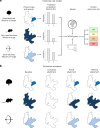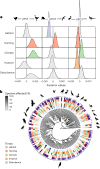Threat reduction must be coupled with targeted recovery programmes to conserve global bird diversity
- PMID: 40555799
- PMCID: PMC12328217
- DOI: 10.1038/s41559-025-02746-z
Threat reduction must be coupled with targeted recovery programmes to conserve global bird diversity
Abstract
Ambitious international commitments have been made to preserve biodiversity, with the goal of preventing extinctions and maintaining ecosystem resilience, yet the efficacy of large-scale protection for preventing near-term extinctions remains unclear. Here, we used a trait-based approach to show that global actions-such as the immediate abatement of all threats across at least half of species ranges for ~10,000 bird species-will only prevent half of the projected species extinctions and functional diversity loss attributable to current and future threats in the next 100 years. Nonetheless, targeted recovery programmes prioritizing the protection of the 100 most functionally unique threatened birds could avoid 68% of projected functional diversity loss. Actions targeting 'habitat loss and degradation' will prevent the greatest number of species extinctions and proportion of functional diversity loss relative to other drivers of extinction, whereas control of 'hunting and collection' and 'disturbance and accidental mortality' would save fewer species but disproportionately boost functional richness. These findings show that conservation of avian diversity requires action partitioned across all drivers of decline and highlight the importance of understanding and mitigating the ecological impacts of species extinctions that are predicted to occur even under optimistic levels of conservation action.
© 2025. The Author(s).
Conflict of interest statement
Competing interests: The authors declare no competing interests.
Figures












References
-
- Rockström, J. et al. A safe operating space for humanity. Nature461, 472–475 (2009). - PubMed
-
- Purvis, A. et al. Status and trends—nature. In The Global Assessment Report on Biodiversity and Ecosystem Services (eds Brondízio, E. S. et al.) Chapter 2.2 (IPBES Secretariat, 2019); 10.5281/zenodo.5517457
-
- Cadotte, M. W., Carscadden, K. & Mirotchnick, N. Beyond species: functional diversity and the maintenance of ecological processes and services. J. Appl. Ecol.48, 1079–1087 (2011).
-
- Tilman, D. et al. The influence of functional diversity and composition on ecosystem processes. Science277, 1300–1302 (1997).
MeSH terms
Grants and funding
- NE/S007261/1/RCUK | Natural Environment Research Council (NERC)
- NE/Z000130/1/RCUK | Natural Environment Research Council (NERC)
- NE/T006579/1/RCUK | Natural Environment Research Council (NERC)
- PRG2142/Eesti Teadusagentuur (Estonian Research Council)
- MOBERC100/Eesti Teadusagentuur (Estonian Research Council)
LinkOut - more resources
Full Text Sources

